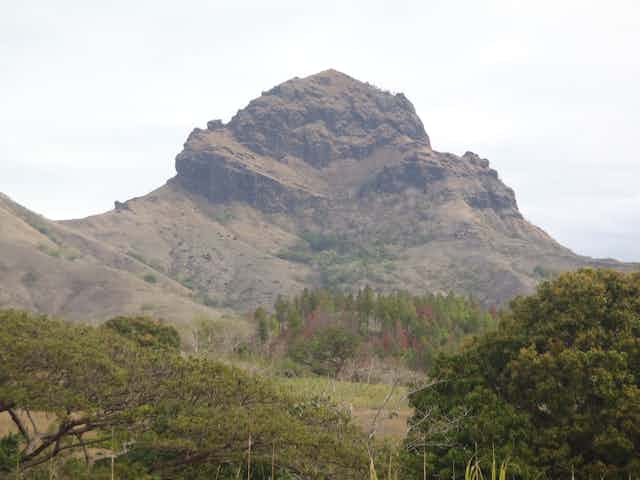Last month I spent some time in Navunievu, a coastal village near the western tip of Vanua Levu island in Fiji. The people of Navunievu worry about sea-level rise and their concern is not exaggerated. Every high spring tide, much of the lower part of the village is flooded (it never used to be).
Off the coast are the remains of two seawalls intended to keep out the ocean. One, built in the 1950s, is now levelled by the waves. The other, built more recently nearer the shore, has collapsed in most places, the sea eating away at the sand behind it, undermining the closest buildings.
Island nations are often considered to be on the front line of climate change. But are islands really as vulnerable as this? One way of understanding the effects of sea-level changes on Pacific Island peoples is to look to the past.
My research shows that sea-level changes in the Pacific have triggered dramatic upheavals in island society.
Spreading across the Pacific
The earliest people reached Pacific islands more than 3,000 years ago, making ocean journeys of more than 2,000 km to reach the Mariana Islands, probably from the Philippines. To the south, they journeyed at least 900 km on the final leg of their island-hopping route from Papua New Guinea to Fiji. These are incredible achievements when you consider that people in most other parts of the world at this time rarely sailed out of sight of land.
There is good information about the early settlement history of five island groups in the western Pacific: the Bismarck Archipelago (Papua New Guinea), Fiji, Mariana Islands, New Caledonia and Vanuatu.
In each island group, the earliest phase of settlement was based largely on marine foraging, as the colonisers took advantage of the abundant food available on the pristine reefs fringing many island shores.
Most days it did not take much effort for people to feed themselves, so there was plenty of time to manufacture pottery - some exquisitely decorated - shell jewellery and stone tools, and probably to indulge in wood carving and tattooing.
But this fragile paradise began to crumble after a few hundred years. Pottery decoration became cruder, more rushed perhaps, while the dependence on marine foods decreased and agriculture became increasingly important.
Eventually, the near-reef founder settlements were abandoned in many places in favour of new ones. These were typically around the mouths of large rivers, where farming was easier. People living here made only plain pottery and had no time to pursue the manufacture of jewellery; culture became pragmatic. Through the lens of history, the transformation could perhaps be seen as cultural collapse.
Rise and fall
What could have caused this? The key lies in the timing: the “collapse” occurred simultaneously about 2,600 years ago throughout these western Pacific island groups. This means we have to look beyond individual islands for an explanation.
The most likely explanation is sea-level fall. At the time of first colonisation, sea level in the Pacific was falling; it fell perhaps 2 m between 4,000 and 1,200 years ago, a period including the times when almost every Pacific island was first occupied.
Sea level fell around 90 cm within the early phase of settlement of western island groups, causing increasing stress to reef ecosystems and resulting in reduced food supply for coastal dwellers.
Centuries later, we find another example of how sea-level change caused fundamental change to Pacific Island societies.
Around AD 1300 there was rapid global cooling, which was followed shortly by rapid sea-level fall – perhaps as much as 50-70 cm within 100 years in the Pacific. The effects on coastal societies in the Pacific region were profound.
Consider that for up to 2,000 years in most central and western Pacific island groups, people lived along island coasts. Then abruptly, around AD 1300, everything began to change. Coastal settlements were abandoned, people moved inland, upslope, even to uninhabited resource-poor islands elsewhere. Hill forts were constructed and weapons of war manufactured for the first time; societies collapsed.
It is the synchrony of collapse that again provides the key to the cause of this event. In almost every island group in the Pacific - from Solomon Islands and Fiji in the west to Rapa and Easter Island in the east – the first signs of collapse appear around AD 1300 with almost all hill forts beginning to be occupied around AD 1400.
As with the earlier period, we have to look for a regional explanation, not a series of unrelated local causes. And sea-level fall appears most likely. Rapid sea-level fall along Pacific island coasts would have lowered coastal water tables, slowed water circulation within lagoons and killed (through exposure) the most productive parts of coral reefs.
A food crisis would have resulted for coastal dwellers. Conflict followed. So people fled inland where they stayed, more or less, for several hundred years.
This research shows there is good reason to believe that the livelihoods of island peoples are especially sensitive to sea-level change.
The corollary is that we are wise to focus on what is happening to Pacific Island coasts affected by rising sea level.
Patrick will be on hand for an Author Q&A between 3 and 4 pm AEDT on Wednesday, March 15, 2016. Post your questions in the comments section below.

